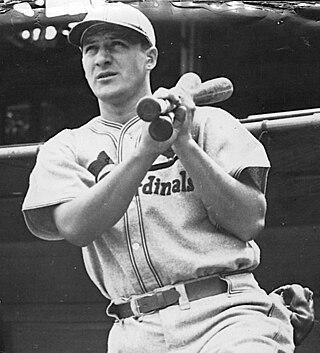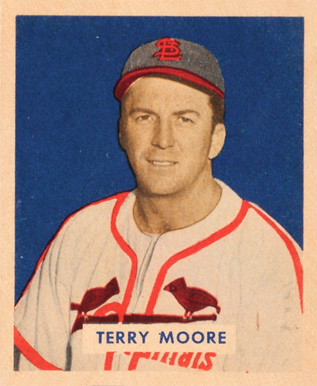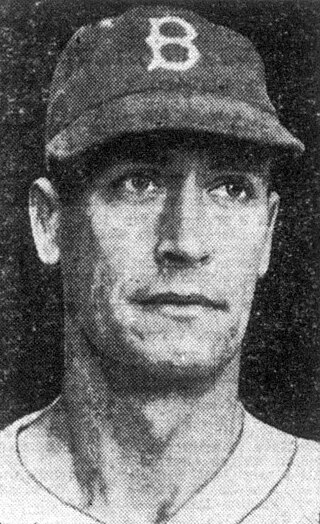Related Research Articles

Jay Hanna "Dizzy" Dean, also known as Jerome Herman Dean, was an American professional baseball pitcher. During his Major League Baseball (MLB) career, he played for the St. Louis Cardinals, Chicago Cubs, and St. Louis Browns.

Johnny Leonard Roosevelt "Pepper" Martin was an American professional baseball player and minor league manager. He was known as the "Wild Horse of the Osage" because of his daring, aggressive baserunning abilities. Martin played in Major League Baseball as a third baseman and an outfielder for the St. Louis Cardinals during the 1930s and early 1940s. He was best known for his heroics during the 1931 World Series, in which he was the catalyst in a Cardinals' upset victory over the Philadelphia Athletics.

Leo Ernest Durocher, nicknamed "Leo the Lip" and "Lippy", was an American professional baseball player, manager and coach. He played in Major League Baseball as an infielder. Upon his retirement, he ranked fifth all-time among managers with 2,008 career victories, second only to John McGraw in National League history. Durocher still ranks twelfth in career wins by a manager. A controversial and outspoken character, Durocher's half-century in baseball was dogged by clashes with authority, the baseball commissioner, the press, and umpires; his 95 career ejections as a manager trailed only McGraw when he retired, and still ranks fourth on the all-time list. He won three National League pennants and one world championship.

Joseph Michael Medwick, nicknamed "Ducky" and "Muscles", was an American Major League Baseball player. A left fielder with the St. Louis Cardinals during the "Gashouse Gang" era of the 1930s, he also played with the Brooklyn Dodgers, New York Giants (1943–1945), and Boston Braves (1945). Medwick is the last player to win the National League Triple Crown (1937).

Frank Francis Frisch, nicknamed "the Fordham Flash" or "the Old Flash", was an American professional baseball second baseman and manager. He played in Major League Baseball (MLB) for the New York Giants (1919–1926) and St. Louis Cardinals (1927–1937), and managed the Cardinals (1933–1938), Pittsburgh Pirates (1940–1946), and Chicago Cubs (1949–1951). He is a member of the National Baseball Hall of Fame and Museum and the St. Louis Cardinals Hall of Fame Museum. He is tied with Yogi Berra for most World Series doubles at 10 and holds the record for the most World Series hits at 58 for a player who never played for the New York Yankees, exceeded only by Berra and Mickey Mantle.

William Boyd McKechnie was an American professional baseball player, manager and coach. He played in Major League Baseball as a third baseman during the dead-ball era. McKechnie was the first manager to win World Series titles with two teams, and remains one of only three managers to win pennants with three teams, also capturing the National League title in 1928 with the St. Louis Cardinals. His 1,892 career victories ranked fourth in major league history when he ended his managing career in 1946, and trailed only John McGraw's NL total of 2,669 in league history. He was nicknamed "Deacon" because he sang in his church choir and generally lived a quiet life.
The 1934 World Series was the championship series in Major League Baseball for the 1934 season. The 31st edition of the World Series, it matched the St. Louis Cardinals against the Detroit Tigers. The Cardinals' "Gashouse Gang" won in seven games for their third championship in eight years.
The 1928 World Series was the championship series in Major League Baseball for the 1928 season. The 25th edition of the World Series, it matched the American League champion New York Yankees versus the National League champion St. Louis Cardinals. The Yankees beat the Cardinals in four games to win their third championship and become the first team to do back-to-back sweeps.

William Harold Southworth was an American outfielder and manager in Major League Baseball (MLB). As a player in 1913 and 1915 and from 1918 to 1929 for five big-league teams, Southworth took part in almost 1,200 games, fell just short of 1,300 hits and batted .297 lifetime. Southworth managed in 1929 and from 1940 through 1951. He oversaw three pennant-winning St. Louis Cardinals teams, winning two World Series, and another pennant with the Boston Braves, the last National League title in Boston baseball history. As manager of the Cardinals, his .642 winning percentage is the second-highest in franchise history and the highest since 1900.

Terry Bluford Moore was an American professional baseball center fielder, manager, and coach. He played for the St. Louis Cardinals, and later coached for them. Moore managed the 1954 Philadelphia Phillies, taking the reins from Steve O’Neill, for the second half of the season.

Samuel Wilson Breadon was an American executive who served as the president and principal owner of the St. Louis Cardinals of Major League Baseball (MLB) from 1920 through 1947. During that time, the Cardinals rose from languishing as one of the National League's doormats to a premier power in baseball, winning nine NL pennants and six World Series championships. Breadon's teams also established the highest regular season winning percentage of any owner in franchise history at .570. His teams totaled 2,470 wins and 1,830 losses.
The St. Louis Cardinals, a professional baseball franchise based in St. Louis, Missouri, compete in the National League (NL) of Major League Baseball (MLB). Before joining the NL in 1892, they were also a charter member of the American Association (AA) from 1882 to 1891. Although St. Louis has been the Cardinals' home city for the franchise's entire existence, they were also known as the Brown Stockings, Browns, and Perfectos.

Curtis Benton Davis was an American Major League Baseball pitcher. Even though he did not reach the big leagues until he was 30, the right-hander was a two-time National League All-Star over a 13-year career spread among the Philadelphia Phillies (1934–1936), Chicago Cubs (1936–1937), St. Louis Cardinals (1938–1940) and Brooklyn Dodgers (1940–1946).
Clifford Rankin "Pat" Crawford, a.k.a. "Captain Pat", was an American major league baseball player. He graduated from Sumter High School, class of 1919. Crawford graduated from Davidson College, and received his master's degree from The Ohio State University. He played baseball for several semi-pro and minor league teams throughout the 1920s including a stint as the left fielder for the 1922 Kinston Highwaymen in the Eastern Carolina Baseball Association, an independent or "outlaw league" team not affiliated with the National Association. Crawford got his big break in 1929 when he made it to the majors with the New York Giants, which were still being managed by the Hall of Famer John McGraw. On May 26, 1929, Crawford hit a pinch-hit grand slam off Socks Seibold in the sixth inning. Les Bell then hit a seventh-inning pinch-hit grand slam off Carl Hubbell. This was the only time in history that two pinch-hit grand slams were hit in the same game. In 1931 and 1932, he had over 237 and 236 hits respectively for minor league Columbus, Ohio. He went in and out of the majors through the 1934 season and was named league MVP of the American Association while playing for the Columbus Senators in 1932. In 1934, Crawford found himself playing on the world champion St. Louis Cardinals. The last two games of his major league career were World Series games. His teammates on the Gashouse Gang that year included HOFers Frankie Frisch, Leo Durocher, Joe Medwick, Dizzy Dean, and Burleigh Grimes. All told, Crawford had a .280 batting average with 9 home runs and 104 RBI in 318 major league games. He was one of the initial inductees in the Kinston Professional Baseball Hall of Fame on February 11, 1983.
The 1937 St. Louis Cardinals season was the team's 56th season in St. Louis, Missouri and the 46th season in the National League. The Cardinals went 81–73 during the season and finished fourth in the National League.
The 1934 St. Louis Cardinals season was the team's 53rd season in St. Louis, Missouri and the 43rd season in the National League. The Cardinals went 95–58 during the season and finished first in the National League. St. Louis won 18 of their last 23 games to overtake the New York Giants the last two days of the season. In the World Series, they defeated the Detroit Tigers in seven games, winning the last 11–0.
The 1941 Brooklyn Dodgers, led by manager Leo Durocher, won their first pennant in 21 years, edging the St. Louis Cardinals by 2.5 games. They went on to lose to the New York Yankees in the World Series.
The 1934 Detroit Tigers season was the 34th season for the Detroit Tigers since entering the American League in 1901. The Tigers won the American League pennant with a record of 101–53, the best winning percentage in team history. The team made its fourth World Series appearance, but lost the 1934 World Series to the St. Louis Cardinals 4 games to 3.
William Pinkney DeLancey was an American professional baseball player during the 1930s. As a 22-year-old rookie catcher in 1934, he helped to lead the St. Louis Cardinals' fabled Gashouse Gang team to the world championship; but, after only one more full big-league season, he was stricken with tuberculosis, effectively ending his playing career.
The St. Louis Cardinals, a professional baseball franchise based in St. Louis, Missouri, compete in the National League (NL) of Major League Baseball (MLB). After decades of early futility in the National League, St. Louis baseball encountered a renaissance with 11 World Series titles and 18 National League pennants since 1926. Sam Breadon's purchase of the majority stake in the club in 1920 spurred this revival; he then assumed the role as team president and assigned the young, enterprising Branch Rickey as his business manager, functioning as a prototype of today's general manager. In his tenure as owner until 1947, Breadon's Cardinals won nine NL pennants and six World Series titles. During this era in Cardinals franchise history, they also totaled 2,898 wins and 2,171 losses in the regular season for a .572 winning percentage.
References
- ↑ "Dizzy, Dazzy and Ducky". thisgreatgame.com. Retrieved March 15, 2011.
- 1 2 Jack Cavanaugh (2015). Season of '42: Joe D, Teddy Ballgame, and Baseball?s Fight to Survive a Turbulent First Year of War. Sports Publishing. p. 76. ISBN 978-1-61321-799-3.
- ↑ Robinson, Alan (March 30, 2007). "Turn on the lights; party's over as McKechnie Field gets lights". USA Today. Retrieved February 14, 2012.
- ↑ "Sparky Adams". baseballbiography.com. Retrieved March 14, 2008.
- ↑ The day the Cardinals played in Stamford: Excerpt from Season of '42, Stamford Advocate (Connecticut), Jack Cavanaugh, April 28, 2012.